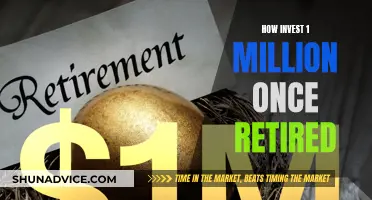
If you have $10,000 to invest, it's important to first determine your financial goals, risk tolerance, and time horizon. Here are some options to consider when deciding how to invest your money:
1. Pay off high-interest debt: Getting rid of high-interest debt, such as credit card balances, can be a wise decision before investing. This will save you money on interest payments and improve your overall financial situation.
2. Build an emergency fund: Having an emergency fund is crucial to cover unexpected expenses, such as medical bills or job loss. Most experts recommend saving three to six months' worth of living expenses.
3. Open a high-yield savings account: Putting your money in a high-yield savings account can provide a safe and liquid option while you explore other investment opportunities.
4. Contribute to a retirement account: Funding a 401(k) or an Individual Retirement Account (IRA) can help you save for the long term. If your employer offers a 401(k) match, try to contribute enough to get the full match.
5. Invest in an index fund or individual stocks: You can open a brokerage account and invest in index funds or individual stocks. Index funds offer a diversified and relatively stable option, while investing in individual stocks allows you to own a piece of specific companies.
6. Consider alternative investments: You may also explore alternative investments such as real estate, commodities, or collectibles. However, these investments tend to be riskier and may require more research and expertise.
| Characteristics | Values |
|---|---|
| Timeframe | Long-term |
| Risk appetite | Low to medium |
| Investment types | Savings accounts, CDs, stocks, bonds, ETFs, REITs, commodities, mutual funds, brokerage accounts, 401(k)s, IRAs, HSAs, robo-advisors, etc. |
| Investment goals | Emergency fund, pay off high-interest debt, retirement, education, etc. |
What You'll Learn

Pay off high-interest debt
Paying off high-interest debt is a crucial step towards achieving financial freedom and security. Here are some detailed instructions and considerations to help you effectively tackle high-interest debt with a sum of $10,000:
Identify High-Interest Debt
The first step is to identify which of your debts has the highest interest rate. This is likely to be credit card debt, but it could also include other forms of debt such as payday loans. Review the terms and conditions of each of your credit accounts to determine the applicable interest rates.
Understand the Impact of High-Interest Debt
High-interest debt can be extremely detrimental to your financial health due to the concept of compound interest. With this type of debt, interest is continually added to your principal balance, and subsequent interest calculations are based on this new, higher balance. This can cause your debt to snowball over time, making it increasingly difficult to pay off.
Prioritize High-Interest Debt Repayment
When deciding which debts to pay off first, prioritize those with the highest interest rates. This strategy, known as the "avalanche method," can help you save a significant amount of money in interest payments over time.
Make a Plan and Stick to It
Commit to making at least the minimum monthly payments on all your debts. Then, allocate any extra funds you can spare towards paying off the debt with the highest interest rate. Once that particular debt is paid off, redirect the money you were putting towards it towards the debt with the next-highest interest rate, in addition to continuing to make minimum payments on your other accounts.
Stay Motivated
While the avalanche method is financially prudent, it can be challenging to stay motivated when facing high balances and long repayment timelines. To combat this, consider incorporating elements of the "snowball method." This strategy involves focusing on paying off your smallest debts first, regardless of their interest rates, to gain a sense of progress and quick wins.
Consider Debt Consolidation
If you're dealing with multiple high-interest debts, you may benefit from debt consolidation. This involves combining all your loans or debts into a single loan with one interest rate. This can simplify your finances and, if you qualify for a lower interest rate, reduce your overall debt burden. However, be cautious of potential upfront costs and ensure you understand the repayment terms.
Maintain a Long-Term Perspective
Remember that paying off high-interest debt is a marathon, not a sprint. It may take months or even years to become completely debt-free. Stay disciplined, consistent, and patient, and you'll eventually reap the rewards of your efforts.
Fidelity's Investor Numbers
You may want to see also

Build an emergency fund
Building an emergency fund is a crucial part of any financial plan. This fund will act as a safety net, protecting you from financial shocks and helping you get back on track. While it may seem daunting, it is an achievable goal and a necessary one, especially in uncertain economic times.
The general rule of thumb is to save between three and six months' worth of household expenses in your emergency fund. This will provide a financial buffer if you experience a loss of income or unexpected costs, such as car repairs or medical bills. To determine your target amount, calculate your average monthly expenses and multiply that number by three, as a starting point.
For example, if your monthly expenses total $3,000, aim to save at least $9,000 as your initial goal. This may seem like a large sum, but there are several strategies to help you get there:
- Create a savings habit: Set a clear goal and make consistent contributions. Treat your savings like a recurring bill and dedicate a portion of your paycheck to your emergency fund.
- Manage your cash flow: Keep track of when money is coming in and going out. Adjust due dates for bills and take advantage of weeks when you have extra money to boost your savings.
- Take advantage of one-time opportunities: Use windfalls, such as tax refunds or cash gifts, to quickly boost your emergency fund.
- Make your saving automatic: Set up recurring transfers from your checking account to your savings account. You can decide on the amount and frequency, ensuring a consistent contribution to your savings.
- Save through work: If you receive your paycheck through direct deposit, ask your employer to divide it between your checking and savings accounts.
It is important to choose a safe and accessible place for your emergency fund, such as a bank or credit union account, a prepaid card, or even keeping cash on hand. Remember, the key is to keep this fund separate from your everyday spending and only use it for true emergencies.
While it may take time and discipline to build your emergency fund, it is well worth the effort. Having this financial cushion will give you peace of mind and help you navigate life's unexpected challenges.
Seeking Investors? Ask Confidently
You may want to see also

Open a high-yield savings account
Opening a high-yield savings account is a great way to invest $10,000. High-yield savings accounts are similar to traditional savings accounts but generally offer much higher interest rates. This means you will be able to build up your savings more efficiently.
High-yield savings accounts are ideal for emergency funds, as they allow you to earn interest on your savings without risking your money and still being able to access it if you need to. They are also a good option if you are saving for a major purchase, such as a new appliance or a down payment on a vehicle.
When choosing a high-yield savings account, consider the following:
- Interest rate: Look for an account with a high annual percentage yield (APY). The national average APY for savings accounts is currently 0.45%, so aim for an account that offers at least 10 times that rate.
- Requirements for opening an account: Some high-yield savings accounts require a minimum deposit, which can range from $0 to $1,000 or more.
- Fees: Read the fine print to understand any fees associated with the account, such as monthly maintenance fees or charges for transferring funds.
- Access to funds: Consider whether you want physical branch access or a large ATM network. If so, choose a financial institution with locations and ATMs in your area.
- Online and mobile platforms: Explore the bank's online and mobile platforms to ensure they meet your needs and expectations.
- Customer service: Think about how you prefer to communicate and ensure the bank offers those options.
- My Banking Direct: 5.55% APY, no monthly fee, $500 minimum opening deposit
- UFB Direct: 5.25% APY, no minimum deposit requirement or monthly fees
- Credit Karma Money Save: 5.10% APY, no minimum deposit requirement or monthly fees
- Varo: 5.00% APY if you receive qualifying direct deposits of $1,000 or more or have a positive balance in both your Varo bank and savings accounts; 3.00% APY otherwise
- BrioDirect: 5.30% APY, $5,000 minimum opening deposit, no monthly maintenance fees
Homes: The Ultimate Investment?
You may want to see also

Get your 401(k) match
If you have a workplace retirement plan, such as a 401(k), be sure to take advantage of your employer's 401(k) match if they offer one. This is essentially "free money" and can significantly boost your retirement savings over the long term.
A 401(k) match is when your employer contributes money to your 401(k) account based on what you contribute. The specific terms of 401(k) plans vary, but typically, employers match a percentage of employee contributions up to a certain limit. This limit may be imposed in a few different ways. For example, your employer may match your contributions dollar-for-dollar up to a certain percentage of your total compensation, or they may match a percentage of your contributions up to a certain dollar amount.
It's important to note that not all employers offer 401(k) matching, and it's not required by law. However, if your employer does offer matching, it's in your best interest to contribute enough to qualify for the full match. This means that you should try to contribute the maximum amount that your employer will match. Doing so will help you make the most of this benefit and boost your retirement savings.
To maximise your 401(k) match, consider the following:
- Start making 401(k) contributions immediately, even if your employer has a waiting period before they begin matching.
- Always contribute enough to get the full match.
- Sign up for automatic 401(k) contributions through payroll deductions.
- Resist the temptation to withdraw your 401(k) funds, even during market downturns.
By following these tips and taking advantage of your employer's 401(k) match, you can increase your retirement savings and work towards a more secure financial future.
Smart Ways to Invest $5,000 Today
You may want to see also

Invest through a self-directed brokerage account
Investing through a self-directed brokerage account is a great option if you want to have complete control over how you invest your money. This means you are not restricted to a narrow selection of funds chosen by a financial advisor or your employer. Instead, you can invest in individual stocks, bonds, options, and more.
A self-directed brokerage account is particularly useful if you want to invest in a variety of asset classes. You can choose from a wide range of investment options, including mutual funds, exchange-traded funds (ETFs), stocks, bonds, and real estate investment trusts (REITs).
There are several benefits to this approach. Firstly, you can often access lower-cost investment options, which can save you a significant amount of money over time. Secondly, you have more precision in selecting specific funds or stocks that align with your investment goals. Finally, you avoid potential conflicts of interest that may arise when working with a financial advisor, as some advisors may be incentivized to recommend products with higher fees.
However, it's important to consider the drawbacks of self-directed investing. It requires a high level of time commitment and knowledge to effectively manage your own investment portfolio. Additionally, you may face higher risks if you invest in certain securities or derivatives.
When choosing a broker for a self-directed account, consider factors such as commission prices, fund selection, and account fees. Online discount brokers are often a good option, as they offer low commissions and a wide range of investment choices.
By taking a self-directed approach, you can make investment decisions that align with your goals and preferences. However, it's crucial to carefully weigh the advantages and disadvantages before proceeding.
Gamestop: The People's Stock
You may want to see also
Frequently asked questions
A good investment strategy depends on your financial goals and risk tolerance. If you're looking for a hands-off approach, consider a robo-advisor, which uses computer algorithms to manage your investments for an annual fee. If you want to pick your investments, consider a mix of stocks, bonds, and cash equivalents, such as ETFs or managed funds.
You can invest $10,000 in the stock market by opening a brokerage account and purchasing individual stocks or funds, such as index funds or ETFs. Diversify your portfolio by owning a mix of assets to balance risk and return.
Alternative investments include private equity, peer-to-peer lending, real estate, derivatives, commodities, cryptocurrency, and collectibles. Consider your risk tolerance and conduct thorough research before investing in alternative assets.
Investing $10,000 in a retirement account, such as a 401(k) or IRA, offers tax advantages and helps you save for the long term. Take advantage of any employer match in your 401(k) to maximize your returns.







